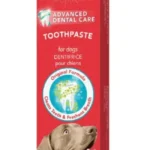How does brushing time go for you and your pup? I imagine you wrestle with a wiggly, heavy pet trying to open his jaws while he refuses, thinking you are betraying him. Most dogs don’t like to brush their teeth and it may be time for you to try the brushless toothpaste for dogs.
No more chasing your dog with a toothbrush. Brushless toothpaste for dogs is an effective and stress-free option to maintain your dog’s dental hygiene. Since you are not scrubbing, does it really work? What are the ingredients and is it vet-approved? You are about to find out.
What Is Brushless Toothpaste for Dogs and How Does It Work?
It is a type of toothpaste that uses biochemical action to break down bacteria, plaque and tartar from the dog’s teeth. Unlike traditional dog toothpaste, it doesn’t require mechanical brushing to remove plaque. Here’s how:
- Enzymatic Action: Many brushless toothpastes contain enzymes like glucose oxidase and lactoperoxidase. The enzymes disrupt bacterial cell walls and prevent biofilm formation.
- Natural Abrasives: Ingredients such silica or diatomaceous earth gently scrub teeth as your dog chews or licks the product.
- Antimicrobial Agents: Compounds like chlorhexidine (in vet-prescribed formulas) or coconut oil (natural option) combat bacteria that cause bad breath and gum disease.
Does It Really Fight Plaque and Tartar?
Yes. A 2018 study in the Journal of Veterinary Dentistry found that enzymatic toothpastes reduced plaque by 20-30% over 30 days without brushing. However, for dogs with severe tartar buildup, a professional cleaning may still be necessary.
What’s in Brushless Toothpaste for Dogs?
Not all brushless toothpastes are created equal. Here’s a breakdown of key ingredients and what to avoid:
Safe & Effective Ingredients
| Ingredient | Function |
| Glucose Oxidase | Enzyme that breaks down plaque-forming bacteria. |
| Baking Soda | Mild abrasive that neutralizes odors (but avoid large amounts—can upset stomach). |
| Parsley/Chlorophyll | Natural breath fresheners. |
| Coconut Oil | Contains lauric acid, which has antibacterial properties. |
| Diatomaceous Earth | A gentle abrasive that polishes teeth. |
Dangerous Ingredients to Avoid
- Xylitol: Extremely toxic to dogs—causes hypoglycemia and liver failure.
- Sodium Lauryl Sulfate (SLS): Can irritate a dog’s digestive system.
- Artificial Sweeteners & Dyes: Linked to allergies and hyperactivity.
Myth Buster: “Coconut oil alone is enough for dog dental care.”
While coconut oil has antibacterial benefits, it doesn’t remove plaque mechanically. It’s best used with other active ingredients.
How Is Brushless Toothpaste Different From Regular Dog Toothpaste?
There are a few differences between brushless toothpaste and regular dog toothpaste. Here is a table to explain the differences better.
| Traditional Toothpaste | Brushless Toothpaste | |
| Application | Requires brushing (often a struggle). | Applied via treats, gels, or food additives. |
| Effectiveness | Better plaque removal if brushing is done. | Works passively but may need supplementation. |
| Best For | Dogs tolerant of brushing. | Anxious dogs, busy owners, multi-pet homes. |
Why Vets Prefer Brushless Toothpaste
We interviewed Dr. Sarah, who explained,“Most pet owners don’t brush their dog’s teeth daily—if at all. Brushless options ensure dogs still get dental benefits without the fight. Enzymatic formulas are clinically proven to reduce plaque, and since they’re easier to use, owners stick with them long-term.” I read an interesting thread on Reddit of a dog owner who brushes their dog’s teeth once a week.
Vet-Approved Benefits
✔ Reduces periodontal disease risk (which affects 80% of dogs over age 3).
✔ Prevents systemic issues (heart/kidney disease linked to oral bacteria).
✔ Improves compliance—no more wrestling matches with your dog.
Benefits for Dogs
- No Brushing Needed: Ideal for dogs who hate toothbrushes.
- Multi-Taskers: Some products double as breath fresheners or dental chews.
- Better Long-Term Results: Owners are more consistent with application.
What Forms Does Brushless Toothpaste for Dogs Come In?
They come in four forms:
- Dental gels- best for dogs who lick it off your finger
- Powder- easier to mix into food
- Sprays- best for quick application
- Chew treats- for dogs who love snacks
Myth: “Dental treats alone are enough.”
While helpful, they’re not a complete solution.
Considerations for Using Brushless Toothpaste on Dogs
Different brands will use different ingredients for their brushless toothpaste. Check if your dog experiences mild stomach upset within the first use, or anytime you change the toothpaste brand. They may have allergies to some ingredients that could cause stomach pain, tiching or GI distress. NEVER use human toothpaste to brush your dogs teeth. It contains fluoride that is toxic to dogs.
Common Questions About Dog Toothpaste (FAQs)
Q: Is Colgate good for dogs?
A: No! Human toothpaste contains fluoride and xylitol, which are poisonous.
Q: Can you use salt as toothpaste for dogs?
A: No—salt can dehydrate gums and cause kidney strain.
Q: What is the healthiest toothpaste for dogs?
A: Look for VOHC-approved, enzyme-based brushless options.
Q: How do I choose a brushless toothpaste for my dog?
A: Choose a VOHC approved toothpaste, one with the flavor your dog loves and without harmful additives such as xylitol, SLS or artificial dyes.
Ready to Try It?
Brushing your dog’s teeth shouldn’t feel like a battle. With brushless toothpaste for dogs, you have all you need to provide effective dental care without the stress. It is backed by science and has vet approval. Whether you choose a gel, powder, or chew, the key is consistency. Your dog’s pearly whites (and fresh breath) will thank you!





